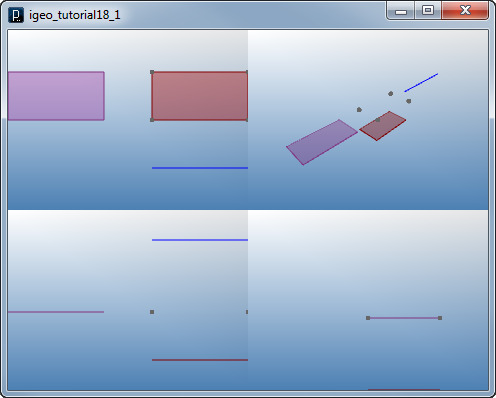

 Python Tutorials Python Tutorials | (back to the list of tutorials) |
 Move (Add / Translate)
Move (Add / Translate)![]()
![]()
![]()
![]()
add_library('igeo')
size(480,360,IG.GL)
pt1 = IVec(0,0,0)
pt2 = IVec(40,0,0)
pt3 = IVec(40,20,0)
pt4 = IVec(0,20,0)
# showing original location
IPoint(pt1)
IPoint(pt2)
IPoint(pt3)
IPoint(pt4)
curve1 = ICurve(pt1.dup(), pt2.dup())
curve1.mv(IVec(0,-20,30)).clr(0,0,1.)
surface1 = ISurface(pt1.dup(), pt2.dup(), pt3.dup(), pt4.dup())
surface1.mv(IVec(0,0,-20)).clr(.5,0,0)
surface2 = ISurface(pt1.dup(), pt2.dup(), pt3.dup(), pt4.dup())
surface2.mv(-60,0,0).clr(.5,.2,.5)

 Duplicate (Copy)
Duplicate (Copy)![]()
![]()
![]()
![]()
add_library('igeo')
size(480,360,IG.GL)
pt1 = IVec(0,0,0)
pt2 = IVec(40,0,0)
pt3 = IVec(40,20,0)
pt4 = IVec(0,20,0)
# showing original location
IPoint(pt1)
IPoint(pt2)
IPoint(pt3)
IPoint(pt4)
curve1 = ICurve(pt1.cp(), pt2.cp())
curve2 = curve1.dup()
surface1 = ISurface(pt1.cp(), pt2.cp(), pt3.cp(), pt4.cp())
surface2 = surface1.dup()
surface3 = surface2.cp().clr(1.0,0,0)
surface4 = surface3.cp(IVec(-60, 0, 0))
 Scale
Scale![]()
![]()
![]()
![]()
add_library('igeo')
size(480,360,IG.GL)
pt1 = IVec(0,0,0)
pt2 = IVec(40,0,0)
pt3 = IVec(40,20,0)
pt4 = IVec(0,20,0)
# showing original location
IPoint(pt1).clr(0)
IPoint(pt2).clr(0)
IPoint(pt3).clr(0)
IPoint(pt4).clr(0)
curve1 = ICurve(pt1.cp(), pt2.cp()).clr(1.,0,0)
curve1.scale(2)
surface1 = ISurface(pt1.cp(),pt2.cp(),pt3.cp(),pt4.cp()).clr(1.)
surface2 = surface1.dup().clr(0,0,.5)
surface1.scale(2.5)
surface2.scale(IVec(20,10,0), 2)

 Scale in 1 Direction
Scale in 1 Direction![]()
![]()
![]()
![]()
add_library('igeo')
size(480,360,IG.GL)
pt1 = IVec(0,0,0)
pt2 = IVec(40,0,0)
pt3 = IVec(40,20,0)
pt4 = IVec(0,20,0)
# showing original location
IPoint(pt1).clr(0)
IPoint(pt2).clr(0)
IPoint(pt3).clr(0)
IPoint(pt4).clr(0)
surface1 = ISurface(pt1.cp(),pt2.cp(),pt3.cp(),pt4.cp()).clr(1.)
surface2 = surface1.dup().clr(0,0,.5)
# scaling in x direction
surface1.scale1d(IVec(1,0,0), 2)
# scaling in vector (1,1,0) direction from center (20,10,0).
surface2.scale1d(IVec(20,10,0), IVec(1,1,0), 3)
# just showing the scaling direction
IVec(1,1,0).show(IVec(20,10,0)).mul(50).size(10).clr(1.,0,0)

 Rotate
Rotate![]()
![]()
![]()
![]()
add_library('igeo')
size(480,360,IG.GL)
pt1 = IVec(0,0,0)
pt2 = IVec(40,0,0)
pt3 = IVec(40,20,0)
pt4 = IVec(0,20,0)
# showing original location
IPoint(pt1).clr(0)
IPoint(pt2).clr(0)
IPoint(pt3).clr(0)
IPoint(pt4).clr(0)
curve1 = ICurve(pt1.cp(), pt2.cp()).clr(1.,0,0)
# rotation around y axis
curve1.rot(IVec(0,1,0), PI/4)
surface1 = ISurface(pt1.cp(),pt2.cp(),pt3.cp(),pt4.cp()).clr(1.)
surface2 = surface1.dup().clr(0,0,.5)
# rotation around z axis
surface1.rot(IVec(0,0,1), PI/4)
# rotation around vector (1,1,1) axis and center (20,10,0).
surface2.cp().rot(IVec(20,10,0), IVec(1,1,1), PI/6)
# just showing the rotation axis
IVec(1,1,1).show(IVec(20,10,0)).mul(10).clr(0)

 Reflect (Mirror)
Reflect (Mirror)![]()
![]()
![]()
![]()
add_library('igeo')
size(480,360,IG.GL)
pt1 = IVec(0,0,0)
pt2 = IVec(40,0,0)
pt3 = IVec(40,20,0)
pt4 = IVec(0,20,0)
# showing original location
IPoint(pt1).clr(0)
IPoint(pt2).clr(0)
IPoint(pt3).clr(0)
IPoint(pt4).clr(0)
curve1 = ICurve(pt1.cp(), pt2.cp()).clr(1.,0,0)
# reflect on a diagonal plane
curve1.cp().ref(IVec(0,-10,0), IVec(0,1,0))
surface1 = ISurface(pt1.cp(),pt2.cp(),pt3.cp(),pt4.cp()).clr(1.)
surface2 = surface1.dup().clr(0,0,.5)
# reflect on yz-plane
surface1.ref(IVec(1,0,0))
# reflect on zx-plane at (0,-20,0)
surface2.ref(IVec(0,-20,0), IVec(0,1,0))

 Shear
Shear
![]()
![]()
![]()
![]()
add_library('igeo')
size(480,360,IG.GL)
pt1 = IVec(0,0,0)
pt2 = IVec(40,0,0)
pt3 = IVec(40,20,0)
pt4 = IVec(0,20,0)
# showing original location
IPoint(pt1).clr(0)
IPoint(pt2).clr(0)
IPoint(pt3).clr(0)
IPoint(pt4).clr(0)
surface1 = ISurface(pt1.cp(),pt2.cp(),pt3.cp(),pt4.cp()).clr(1.)
surface2 = surface1.dup().clr(0,0,.5)
# shearing in x
surface1.shearXY(1, 0)
# shearing in y
surface2.shearXY(IVec(20,10,0), 0, -1.5)

 HOME
HOME
 FOR PROCESSING
FOR PROCESSING
 DOWNLOAD
DOWNLOAD
 DOCUMENTS
DOCUMENTS
 TUTORIALS (Java /
Python)
TUTORIALS (Java /
Python)
 GALLERY
GALLERY
 SOURCE CODE(GitHub)
SOURCE CODE(GitHub)
 PRIVACY POLICY
PRIVACY POLICY
 ABOUT/CONTACT
ABOUT/CONTACT
